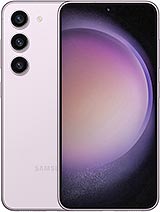Samsung Galaxy S24 review

The competition
The MSRP for a vanilla Galaxy S24 will vary from region to region, and you can get different carrier and vendor deals and bundles. The most popular tier will probably be the 8GB/256GB ($860/€960/£860) one. We recommend against getting the 8GB/128GB ($800/€900/£800) version as the storage is the slower UFS 3.1 variety.

It's pretty hard to shop for a compact flagship nowadays. But putting all of the requirements together, last year's Galaxy S23 comes up first on the list. The highlights of the new model include seven years of software updates, a new LTPO display, slightly bigger battery, and a newer chipset, but hardly any of these is a groundbreaking upgrade. Especially considering that the overall battery life hasn't improved compared to the S23. You can get most of the same experience out of a last-gen model and at a nicely discounted price. Around $390/€655/£465 for a base 8GB/128GB model and $560/€695/£480 for a 8GB/256GB model.

Of course, Apple caters nicely to the compact market as well. While we would love to recommend the iPhone 15 Pro unless you are shopping in the US and are willing to settle for a 128GB unit, it is probably not in the same budget as the vanilla Galaxy S24. Still, the regular iPhone 15 offers a great experience. You will be missing a telephoto cam and you will have to settle for a 60Hz refresh rate too. And, of course, there is the elephant in the room - iOS versus Android, which is a deeply subjective decision.


![]()
Samsung Galaxy S23 • Apple iPhone 15 • Google Pixel 8
A vanilla Google Pixel 8 won't get you anywhere near the performance of a Galaxy S24, but the compact aspect is definitely there. You will be missing out on a telephoto camera, but other than that, there are arguably no major omissions. You also get extended software support, courtesy of Google and plenty of Google-powered AI features. Also, a bigger battery. And the Pixel 8 is notably cheaper.
Throwing the whole "compact" bit out the window and speaking of Google devices, you might want to look into the Pixel 8 Pro as well.
Also, you can swing an entry-level 8GB/256GB or even a much more future-proof 12GB/256GB Galaxy S23 Ultra unit. And sure, you won't be getting the seven years of updates and Samsung AI, at least not initially, but other than that, you are getting "a lot more phone" for your money. A bigger and higher resolution display. An S Pen. You get a more potent main camera and two telephotos. Also, an autofocusing ultrawide and selfie. So, a better camera setup as a whole. The bigger battery and faster charging are also quite nice to have. There is also Ultra Wideband (UWB) if you care about that.
![]()


Google Pixel 8 Pro • Samsung Galaxy S23 Ultra • OnePlus 12
Pricing on the OnePlus 12 also makes it nicely competitive. The larger 6.82-inch display on the OnePlus matches most of the features of the Galaxy S24 and even exceeds it by offering things like 10-bit color and higher brightness. The OnePlus 12 also arguably has a higher-quality camera setup, though that point can be argued. There is autofocus on the ultrawide, at least. The much bigger 5,400 mAh battery is nice to have, much like the faster charging, both wired and wireless.
Our verdict
As mentioned, the Galaxy S24 offers a nice little incremental upgrade over its S23 predecessor without really innovating or breaking the mold in any major way.
The new, much brighter and a bit larger LTPO, 120Hz, Dynamic AMOLED 2X display is a great little step up from last year. The same goes for the new Armor Aluminum 2 frame, which is now complete with a matte finish. We also appreciate the slight bump in both battery capacity and actual battery endurance.
One UI 6.1 is also a nice incremental step up when it comes to general functionality, even if you ignore the major Galaxy AI injection, which, admittedly, is still an "acquired taste" for most users and will take some refinement and normalization before becoming an unquestionable and established value-add.
The allure of seven whole years of software support is far less debatable, though.

Now slightly louder, the hybrid stereo speaker setup remains a highlight of the multimedia experience. The same goes for the solid and versatile camera setup. Samsung didn't make any sweeping changes in this department but arguably didn't really need to either.
It's also hard to argue with the build quality and durability up on offer here. Neither IP68 nor Corning Gorilla Glass Victus 2 are new things, but both remain noteworthy highlights.
As for the whole chipset situation, we see how returning to a two-chip, segmented approach rubs many people the wrong way. We acknowledge that Samsung's own Exynos parts have a pretty bad reputation (deserved, at least in part). Still, from our first batch of testing, the Exynos 2400 variants of the Galaxy S24 and S24+, we can at least say that this year, the Exynos 2400 does seem pretty close in overall performance to the Snapdragon 8 Gen 3.
We are not particularly impressed with how the Exynos-equipped S24 and S24+ handle heat over time. While the thermal-throttling is still perfectly reasonable, we are interested in seeing how the Snapdragon variants of these devices fair in the same department once we eventually get the chance to test those out as well.

That, however, might be a bit of a comparison for "scientific purposes" only since most people won't get the chance to pick and choose their chipset. Plus, at least from an experience standpoint, there doesn't appear to be any major difference one way or the other.
Going into wishful thinking for a bit here, we would have loved to see the vanilla S24 join its bigger siblings and get 45W charging this year. Ultra Wide Band (UWB) would have been a nice extra too. And Samsung just needs to stop offering the UFS 3.1 128GB base storage variant. We get why it's there, but that doesn't mean we have to like it. The same goes for the 8-bit displays, by the way.
In keeping with tradition, the Galaxy S24 continues to be a mighty yet surprisingly compact package. It is one of the few small flagships left out there, and that alone will ensure its popularity with buyers. Also, as usual, it is the cheapest way to get into Samsung's latest flagship line and for better or worse, that appeals to a particular crowd.
If you fall into either camp of interested buyers, we can confidently say that Samsung played it safe yet again and ensured that the Galaxy S24 won't disappoint.
If, however, you crave something other than the Galaxy S "norm" or are deeply bothered by the return of Exynos, you might want to look elsewhere instead. Until the S24's price settles a bit, we'd say the Galaxy S23 provides better value around.
Pros
- No-nonsense, sturdy, grippy, compact design. The new matte finish looks great.
- Even better durability than last year with V2 aluminum frame and still Gorilla Glass Victus 2 and IP68.
- Outstanding OLED screen, slightly bigger and even brighter than last year.
- Great battery life from a slightly bigger battery than last year.
- Awesome stereo speakers.
- Top-notch performance.
- Solid photo and video quality across the board with a camera carried forward from last year.
- Exciting One UI is now infused with plenty of AI; DeX support, and great connectivity options.
Cons
- Hardware fragmentation is back, with some markets getting Snapdragon 8 Gen 3 and some Exynos 2400 chips.
- 128GB uses UFS 3.1 instead of UFS 4.0 storage.
- Still no UltraWideBand (UWB) support.
- No 10-bit color depth support for the screen.
- The CPU and GPU both throttle down in performance quite aggressively under load.
- Charging is still capped at 25W and there is no charger in the box.
Reader comments
- Xogah qide
- 10 Jan 2025
- Ng$
2025 may award 100k least 3 manthe
- SUBHAN
- 10 Jan 2025
- U{B
S24 come in 12 gb ram??
- Anonymous
- 21 Dec 2024
- Ixf
I think about the sound. Stereo speakers are important. I would like something that is louder than my s20. The truck I drive is to noisy

